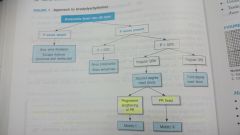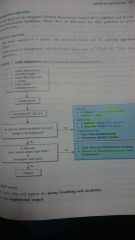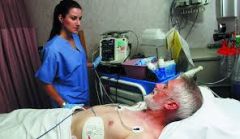![]()
![]()
![]()
Use LEFT and RIGHT arrow keys to navigate between flashcards;
Use UP and DOWN arrow keys to flip the card;
H to show hint;
A reads text to speech;
8 Cards in this Set
- Front
- Back
|
Describe the approach to bradycardia (HR<60bpm) |

|
|
|
Describe the clinical assessment and management of bradyarhythmia in the ED |

|
|
|
What is done in the ED when patient presents with bradycardia? (following the algorithm above) |
1. stabilize ABC, give O2, set up IV lines 2. Attach defibrillator/ECG monitor asap, and also get 12 lead ECG 3. Assess vital signs, take HX and PE 4. Look for serious signs and symptoms: - breathlessness - altered mental status - SBP<90mmHg, shock - Heart failure clinical features 5. Proceed to intervene if serious signs and symptoms are present, otherwise just monitor 6. Prepare for transcutaneous pacing if type 2 2nd degree AV block or 3rd degree heart block |
|
|
What is the mechanism of action of atropine? |
- Vagolytic - inhibits vagal innervation of SA node or AV nodes, does not act on infranodal areas - Thus in 2nd degree type 2 blocks and 3rd degree blocks, which are due to infranodal failure, atropine is unlikely to work contraindication: transplanted heart --> give IV catecholamines or theophylline |
|
|
What is the target to achieve in atropine/inotrope therapy for bradycardia? |
- improvement of signs/symptoms - increased heart rate to 60-70bpm |
|
|
Name some examples of inotropes and vasopressors |
Epinephrine/Adrenaline - 2-10 ug/kg/min Norepinephrine/Noradrenaline Dopamine - 5-20 ug/kg/min Dobutamine Phenylephrine Ephidrine |
|

What is this? Explain the procedure |
Transcutaneous pacing: - explain procedure and obtain consent - administer IV sedation, analgeaia, preoxygenation - apply self adhesive pads to inferior of right clavicle, and on apex - set pacing mode (fixed versus demand mode) - set heart rate to 60-70 bpm - set current output level to minimal setting - turn the pacer ON, and increase the current slowly between 0-200mA |
|
|
What are the causes of sinus tachycardia? |
1. Electrolyte imbalances/ Toxins 2. AMI 3. Use of beta-blockers 4. others: high vagal tone, sick sinus syndrome |

